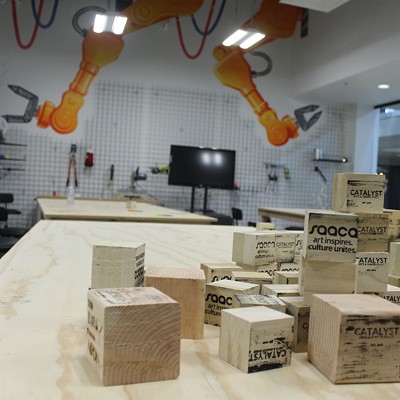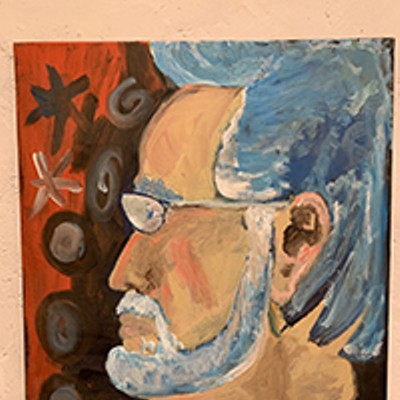"I'd love to move back in," says Andrew Ryan, one of 10 members of the Alamo Woodworkers Cooperative, "but I don't see that as a possibility with rents (in the refurbished building remaining) low enough for artists."
With funding supplied by the city of Tucson, Ryan and some others from the cooperative will be moving a few blocks to the west; he says his rent in the new space will increase by about 40 percent. Others from the group are relocating to a new space north of the Steinfeld building, while two part-time members are getting out of woodworking altogether.
Charles Alexander of Chax Press, along with several other Steinfeld artists, are moving to a building on Ninth Street west of Euclid Avenue. Alexander indicates his rent will go up almost five-fold from the rock-bottom monthly figure of $150 that he has been paying--although he and the other Steinfeld tenants had to do all the maintenance and improvements on the old warehouse.
"We'll have both cooling and heating," Alexander chuckles about his new location--neither of these amenities were provided in the Steinfeld building.
"I'm looking at this optimistically," Alexander says, "and hope the city carries through with its promise of offering us the right of first refusal to return to the Steinfeld building."
When that could happen is anyone's guess. Michael Graham, public information officer for the city's Transportation Department, says his agency has no answers to questions about when rehabilitation work will begin. Plus, he adds: "We're still trying to find funding to support the project."
Based on what he's been told by city officials, David Aguirre, an artist and former master leaseholder of the Steinfeld building, hopes to see the repair work completed by the end of 2009.
In the interim, Aguirre will move his studio across the street from the Steinfeld Warehouse. At the same time, the Dinnerware Gallery he oversees will relocate to the 200 block of East Congress Street, near the spot Dinnerware originally opened many years ago. While the gallery will have extra space, Aguirre indicates its rent will more than double. He says the first show in the new location should be opening in early September.
Until several weeks ago, Aguirre had visions of keeping all the tenants in the Steinfeld building. Based on two reports--one prepared by a structural engineer, the other by an architect--he thought this would be possible after the city acquired the property from the state of Arizona, which initially purchased the building in the early 1980s, intending to tear it down for a since-scrapped road project.
Aguirre recalls he went to a meeting in City Hall in early June which was attended by a large cadre of municipal employees. "The guys in the meeting were 'no, no,'" regarding staying in the structure, Aguirre says. "I pretty much had my ass handed to me on a silver platter."
While no city fire or building inspectors have been inside the building recently, each of three local government safety officials contacted agreed on one thing: The Steinfeld Warehouse has to be vacated once the city acquires it.
"We have concerns for the safety of the occupants," says Ernie Duarte, the director of Development Services Department. "The city would be exposed to a lot of liability. I've seen in the private sector where people stayed in a building under renovation, and it compromised public safety."
The time-consuming process of renovating the 100-year-old building probably won't start for many months. When work does finally begin, it will be focused on several areas--and the sources of funds to pay for each will be different.
As part of its Downtown Links roadway project, the city intends to build a traffic underpass beneath the railroad tracks adjacent to the warehouse. Because of that, the Steinfeld building will have to be structurally shored up to prevent damage; Regional Transportation Authority funds will be used to cover this approximately $1.1 million expense.
Town West, the firm proposing to build a high-rise hotel/condominium project across the street from the warehouse, has agreed to pay for other nonstructural improvements, estimated to run about $400,000.
In a June memorandum to the City Council, city transportation director Jim Glock stated that he believes even more work will have to be done to the warehouse. These repairs would be needed to obtain a certificate of occupancy and bring the warehouse into compliance with the Americans With Disabilities Act.
In his memo, Glock indicates the cost of this extra work should be borne by a master leaseholder of the building, not taxpayers. As part of a contemplated nonprofit organization, Aguirre says he's interested in applying for that responsibility.
At the same time, Aguirre has mixed feelings about his prospects for ever returning to the Steinfeld Warehouse.
"I do think I'll move back in," he says, "but I also think there's a possibility the building will be torn down. Preventing that will take vigilance on my part and is why I'm moving in right across the street so I can watch what's going on."












